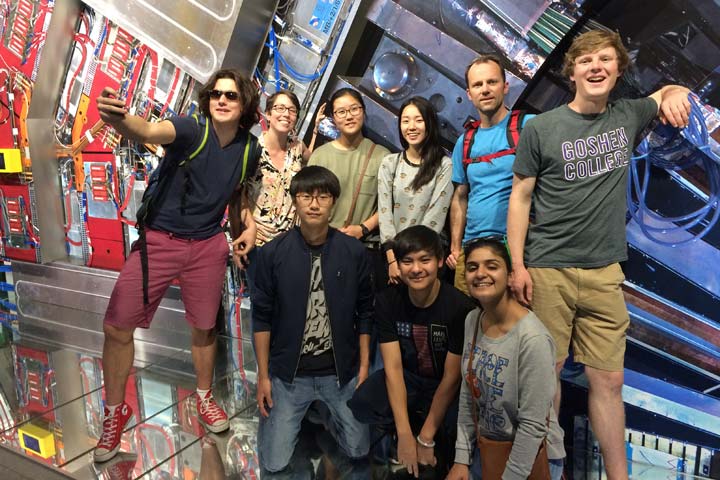
25 May Accelerated learning – Student visit to CERN
Last week seven students had a once-in-a-lifetime opportunity to visit CERN, the European Council for Nuclear Research in Geneva, Switzerland.
CERN is famously home to the Large Hadron Collider, by far the World’s most powerful particle accelerator. It’s also where thousands of physicists and engineers work to expand our understanding of the fundamental structure of the universe. Our students got to spend four full days behind the scenes at CERN, in an immersive educational experience courtesy of some of the World’s greatest scientific minds.
Life Lab, an NGO working to raise the bar in physics and science education in India organised the trip along with Dr Archana Sharma, a senior physicist working at CERN. The Woodstock students were joined by groups from CHIREC International School, Hyderabad and Gokuldham High School, Mumbai.
The trip was thanks to the generous support of Friends of Woodstock School, which made a significant contribution towards the cost.
Here, our students document their experiences and learning in a diary of their time in Geneva.
Our visit to CERN
In Woodstock as students we ultimately work towards combining the knowledge from various academic disciplines to gain a better understanding of ourselves and the world around us. Yet, sometimes we actually have to physically explore the world around us in order to understand it. The main goal of our trip to CERN extends far beyond learning some information about particle physics and quantum mechanics. There are few if any other places on the Earth which are able to simultaneously explore fundamental questions of science and philosophy. This shows through practice how all the theoretical knowledge that we accumulate in the classroom fits together in ‘the real world’ and ultimately allows us to create a framework of our own, which we can use to organize what we learn throughout the rest of our lives.
Armins Stepanjans (Grade 12)
Monday, May 15
Our first morning in Geneva started with four keen group members going out for an early morning run and being weary that cars drive on the ‘other side’ of the road. After breakfast, we headed out to the CERN site (by local tram) and were introduced to an amazing man, Dr Mick Storr. He gave us an introduction and helped us throughout the day to get better understanding of what CERN has done, is doing, and the technology it uses. Dr Mick worked as an experimental particle physicist on software development project before turning to the field of education and is currently with the CERN academic and Technical Training section. He talked about the missions of CERN: to push forward the frontier of knowledge, develop new technologies, and that all its work is for humanity, everyone.
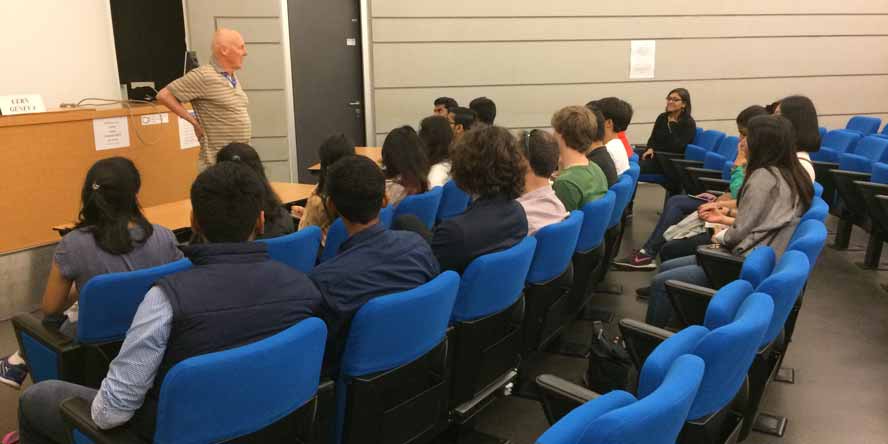
Dr Mick giving us the first of many talks in the lecture room.
While having lunch in the CERN cafeteria, I looked around and saw all kinds of people; short and tall, (very) old and young, female and male, white, black, yellow, and brown in skin colour, and I thought, ‘wow, all these people came here to talk about science, study, think, and create scientific experiences!’ It was astonishing to see all those people in one place, with a single force, science, that brought them together. After the orientation, we visited the Globe of Science and Innovation, a mini museum, to explore the significant research carried out at CERN.
The display of research was very interesting and entertaining to learn from. In the afternoon, Mick challenged us to build a cloud chamber to observe cosmic radiation rays. We explored what scientists do with their experiments and the importance of observation and recording. Getting to know about a topic that I’ve never got to interact with from such passionate people, added up to one of my coolest experience in learning. We will be learning how technologies, used by physicists, in CERN work to find the answer to the questions they ask. I’m looking forward to learn about these topics for the coming up days in CERN.
Sooyeon Park (Grade 11)
Students investigating the effects of seeing ‘real actual’ cosmic rays in a cloud chamber. This experiment is very cool and will be replicated in Woodstock science classes in 2017! Does anyone know where we can get a good supply of dry ice from?
Tuesday, May 16
Our second day at CERN started out with a short introduction on India’s connection with physics research at CERN. We met Dr Archana Sharma, a detector physicist, who has been at CERN for over 30 years. She has a passion for bringing more students (especially from India) to CERN and imparting knowledge about particle physics and so has among other projects begun the Life Lab Foundation, an Indian NGO dedicated to raising the standard of science education in India.
Despite her senior position and very busy schedule overseeing projects at CMS, Archana was very approachable and kind and seemed to really want to get to know us, even insisting we call her by first name. She used an icebreaker, asking for a bit about each of us, making us feel at home before a long and informative day, something I didn’t expect at a research institute like CERN, but made us much more willing to ask questions of the scientists.
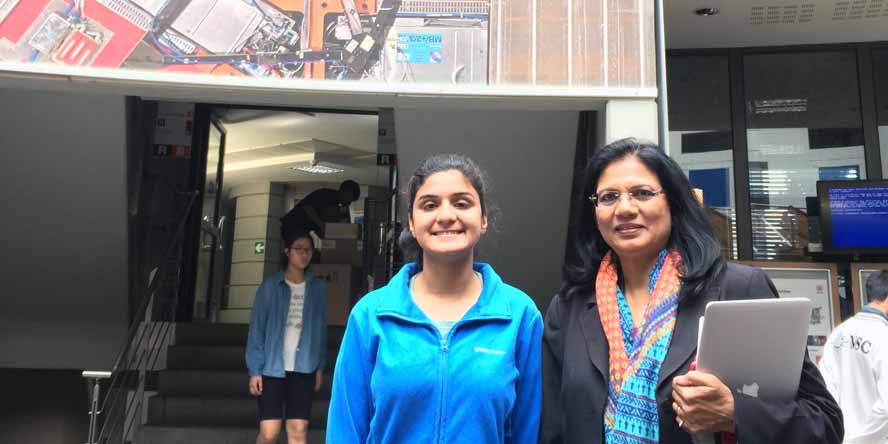
Kahini and Dr. Archana Sharma, leading Indian particle physicist
Archana then launched into a question and answer session to get a feel for what we already knew about the standard model, for example, the significance of the b-meson particle, other details regarding the data sifting and storage in the ATLAS and CMS experiments, and so on. Bit by bit, she drew out what we knew and inserted lessons along the way to prepare us for our afternoon tour of the SC, Synchrocyclotron and ATLAS detectors.
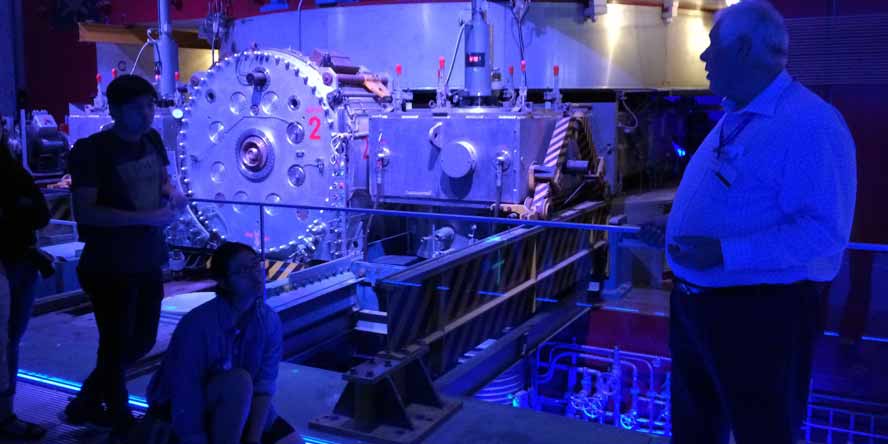
The retired synchrocyclotron a precursor to the SPS which was used to discover the Z and W bosons
This mural is scale at half the size of the actual ATLAS detector!
[vc_masonry_media_grid gap=”2″ grid_id=”vc_gid:1495532481253-0c191f74-7917-9″ include=”25648,25646,25647″]
Students at the ATLAS (A Toroidal LHC ApparatuS) learning about the features of this particle detector and viewing the control room and facilities.
I was really thankful to Archana and Prachi from Life Lab Foundation for giving us this great opportunity, as this visit helped shape our mindsets for the future. Archana is one of the reasons many students like us are being given such an amazing opportunity to visit CERN.
Kahini Dhoat(Grade 11)
Wednesday, May 17 Morning
Today’s morning lecture was with Dr Piotr Traczyk who works in the CMS (Compact Muon Solenoid) detectors. The CMS is a particle detector that is slightly smaller than the ATLAS detector, at around two thirds of the size. Dr Piotr gave us an explanation of the operational aspects, the physical dimension and the different components of the machine. It is 7m wide and 12m long, with a mass of 14 million kg. He said that the machine is “stupidly heavy” and was a logistical effort assembling it 100m underground. We learned that there are two main parts to the CMS; the detector and the electromagnetic calorimeter. The detector tracks the path of the particle and the electromagnetic calorimeter detects the energy of the protons and electrons. In the detector a large powerful magnet (four Tesla strength) separates the positive and negative particles created according to Lorentz law which tells us the direction of the magnetic field and the force depending on the direction of the particle. The outer detector is designed to detect muon – a heavy electron like particle. It was interesting hearing how the physicists use the various detectors to determine what particles were created in the aftermath of the proton collisions. Another interesting point was that they only know that a neutrino particle was created by mass and momentum conservation calculations.
Jaeyeon and Dr. Piotr
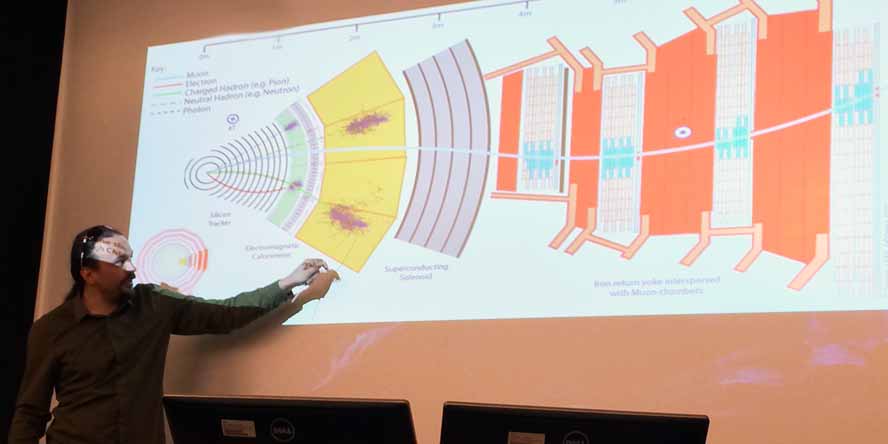
Dr. Piotr explaining how detectors work
Dr Piotr’s Higgs Boson Sonification Video
Dr Piotr also explained the use of the long (15m long and 35 tonnes) ‘dipole’ magnets whose sole purpose is to direct the particles movement around the LHC 27 km ring. There are about 1,200 of the magnets whose job is to move the protons 0.3 degrees so that they can stay in the ‘loop.’ Also, he explained why we need two pipes carrying the protons in the LHC. He said that the reason why there are two pipes carrying the protons is because the two particles that are supposed to collide have the same charge. Therefore, if they are in the same pipe, the magnetic field will change the direction of the particle so that they bend in different directions, which is not what the researchers want to do.
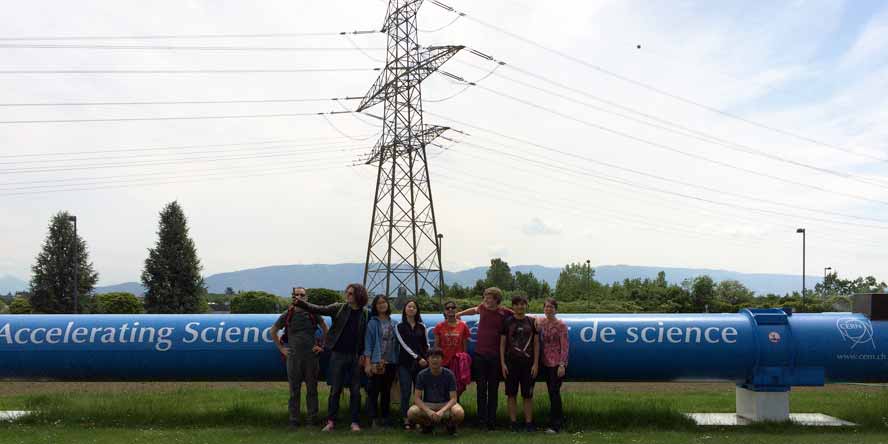
A 15m long dipole magnet
The above picture shows a 15m long dipole magnet – there are 1200 of these placed 100m underground! The morning session helped me understand more about CMS and the purpose of the research.
Jaeyoun Kim (Grade 11)
Wednesday, May 17 Afternoon
On the French side of Swiss-French border, near gracious Swiss vineyards and vast French plains humbly rests the CERN Data Centre. Without the Centre, rest of the CERN would be nothing more than an overpriced set of loops and blinking lights. For me as a computer science enthusiast, visiting the Data Centre was powerful. The opportunity to see in person the facilities that are able to analyse quadrillions of bytes per second was formidable.
The guide explained to us the algorithm design used in filtering such high-volume data, the multiple tier distributed network used in analysing CERN data and various details of implementing such a fabulous data analysis system.
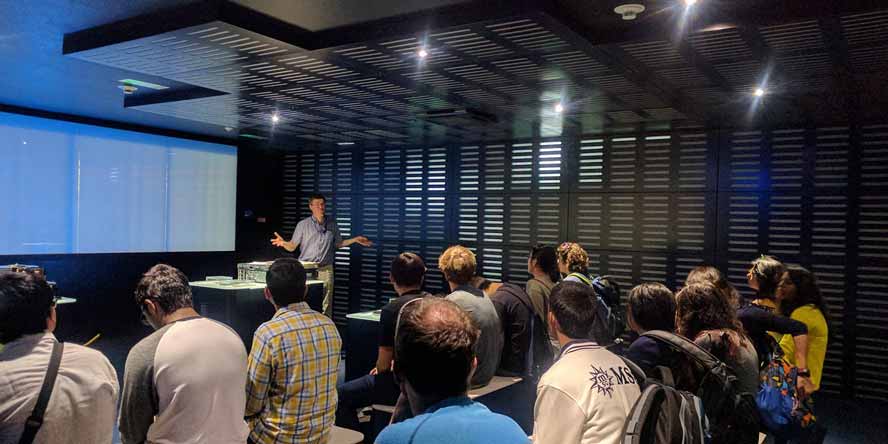
Learning about the Data Centre
The pedagogical capabilities of our guide were also nothing short of spectacular. He was able to explain state of the art data analysis design so simply that even my grandmother would have understood it, yet the explanation did not lose the magnificence of its topic. During the presentation, the guide effectively used a Star Wars like holographic display to demonstrate concepts he was describing. Besides being an extremely helpful visual aid in the guide’s explanation (the guide’s explanation would have been extremely clear even without the visual aid, yet the symbiotic relationship between guide’s speech and the display enhanced the presentation even further) the holographic display also served a role of a curtain, dramatically revealing the server room after the speech.
Armins Stepanjans – computer fanatic! (Grade 12)
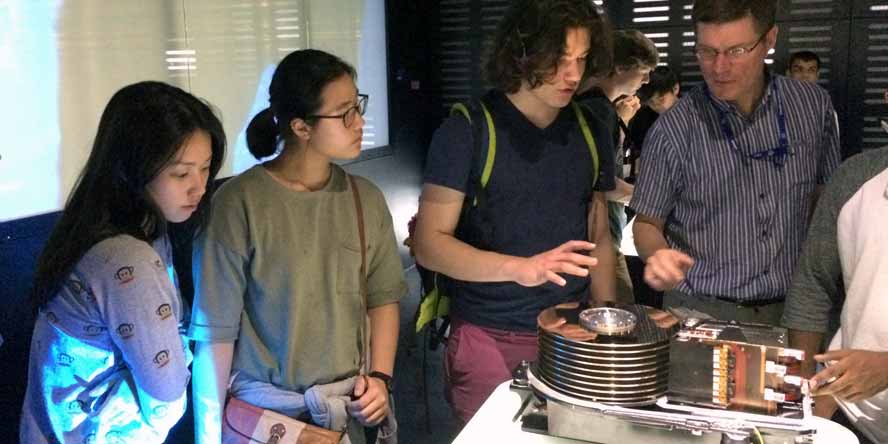
Discussing how computer storage has changed over time to accommodate the massive amounts of information particle collisions produce.
CERN has a long history with the development of information technology. Here we are in front of the room where the world wide web was developed by Tim Berners-Lee.
Thursday, May 18
On Thursday we had a talk on medical applications of the LHC, Large Hadron Collider, by Dr Manjit Dosanjh. I came to know about the medical applications like PET-CT scan, all the advancements in the medical scanner field and how they are trying to cure cancer using LHC technology. I came to know about the radiation caused by the different scanning machines and what impact they have on our bodies. Manjit discussed how far treatments have come since Marie Curie discovered medical uses for radium. The future scanner like PET-MRI which have a lower radioactivity.
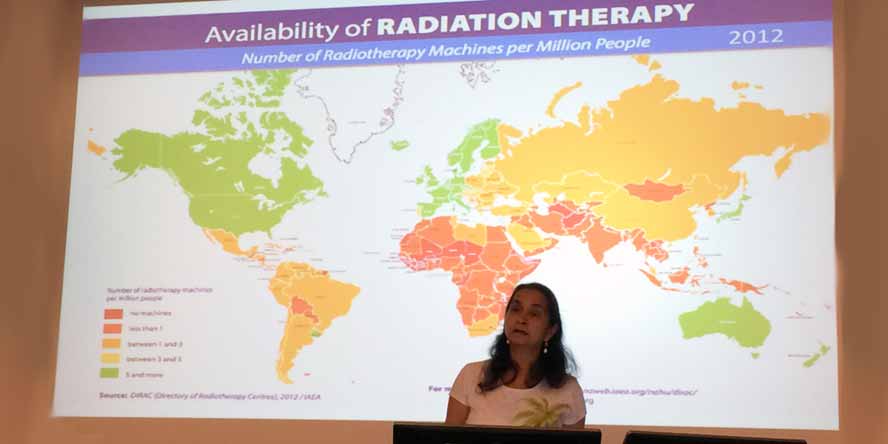
Dr Manjit Dosanjh’s lecture
In the evening we went to the control room and the magnet factory, where we learned about superconductors and why the LHC is so cold and about the accelerators and why they have so many before the particle reaches the LHC. In the control room we wrapped up the whole trip with a review and a clearer understanding of the LHC. And at the end the screen was turned transparent to let us look at the people who work at the control room. In the evening we went shopping where everyone stuffed their bags with chocolate because everyone wanted to take advantage of the variety of chocolate in Switzerland.
Jefferson Wu (Grade 11)
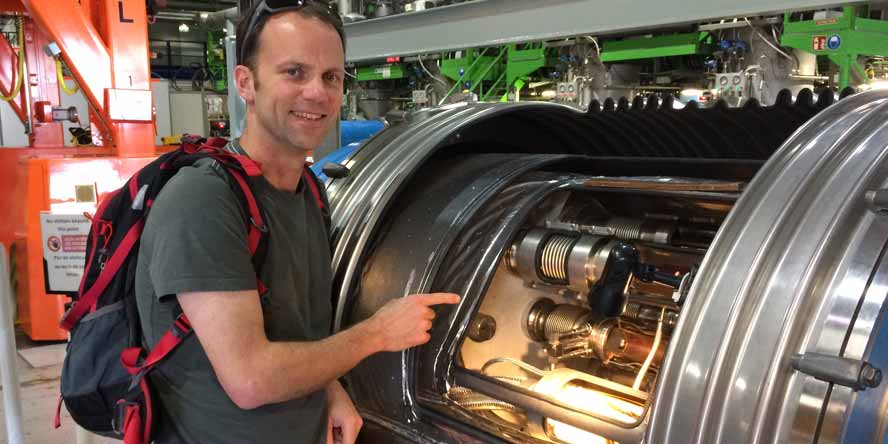
Mr. Anderson with the proton tubes
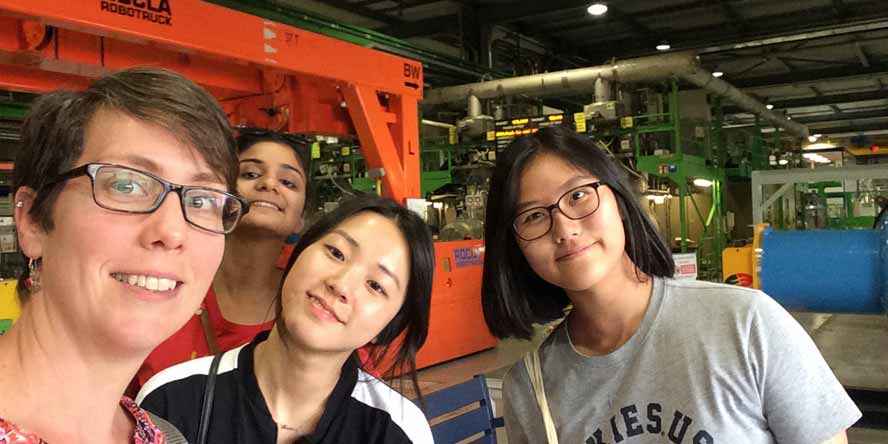
In the magnet testing facility
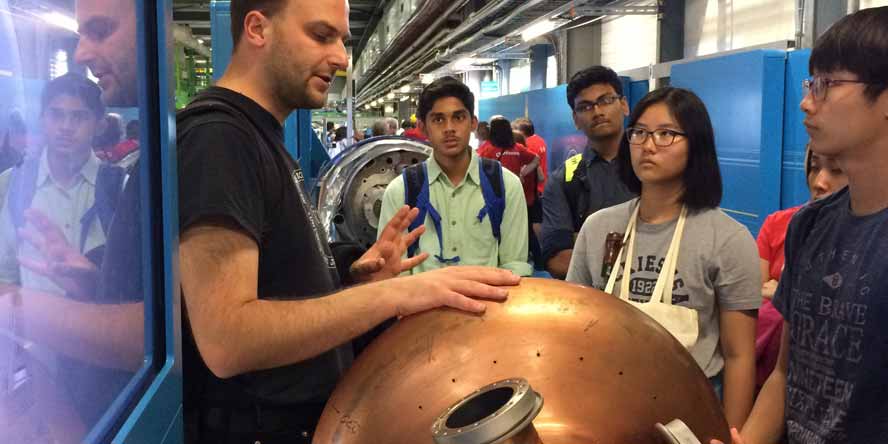
Radiofrequency generator (400 MHz frequency) which is used to accelerates the protons with an alternating electric field!
Friday, May 19
Today was a day out of the ordinary. Unlike the preceding days of CERN which embraced the lecture rooms and different machinery rooms, today was something completely different: a treasure hunt. Which 17-year-old says no to a treasure hunt? With our childhood fantasies of scavenging for treasure like pirates still present in our minds, we were able to re-enact our childhoods in the city of Geneva. Despite our elevated feelings, the weather was disastrous; grey, heavy clouds settled low in the sky and swallowed every sign of sunlight. We were divided into several groups and were given a paper with multiple questions. Starting from the Blandonnet station, we rampaged through Gare Cornavin to the Old Town. From the beginning of the treasure hunt, we were soaked in rain; however, even the rain couldn’t stop our quest. As we wandered around the city of Geneva looking for names of statues, flags, names of streets, dates, a lion fountain, and a cathedral with gold onions, we encountered a problem: French. However, we were able to overcome it by bravely asking random strangers on the street, using our limited French knowledge; “Ques best direction e la Rhone?” and always ending with “Merci beaucoup”. Through the treasure hunt, we were able to take a glance of a small part of Geneva and absorb the beautiful Swiss culture for a few hours. Even though the rain made each movement of ours heavier and more tiring, it made the event more memorable. After the constant running and walking of 10 km in total, we rested our exhausted legs in a small burger shop named Holy Cow.
Healeam Jung (Grade 11)
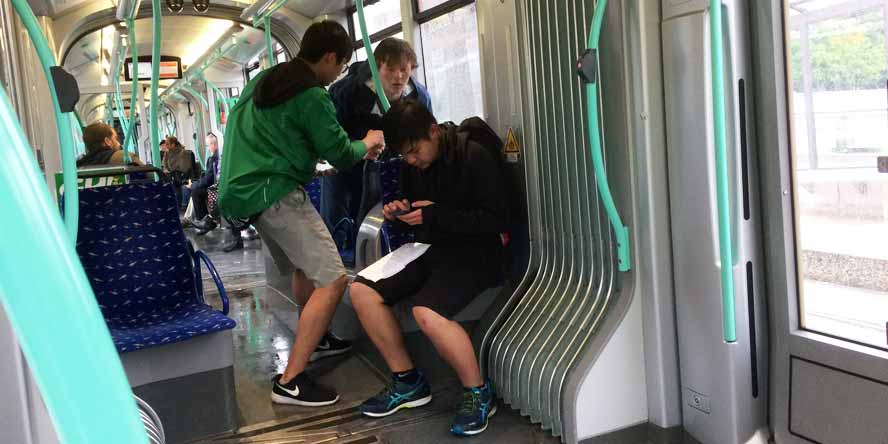
The boys’ team reading up the treasure hunt clues on the tram.
Today we visited the UN headquarters in Geneva, which turned out the be the second largest UN headquarters in the world. It was also the first day that we didn’t go to CERN. While we CERNtainly missed and will miss it, the UN headquarters are really cool. Our tour guide, Eleanor, first took us to a conference room funded and designed by the United Arab Emirates. The carpet and walls together were designed to represent sand dunes. the carpet was orange and had a wavy pattern, and the walls were light wood with a wavy pattern. The chairs and desks were white leather, and needless to say, exceptionally comfortable. Next we got to wander into the old section of the headquarters, built by the League of Nations before the UN even existed. Unfortunately for us, the room was busy being set up for an exhibition by WHO so we didn’t get to see a whole lot. After touring the old wing we went to another assembly room, with equally comfortable chairs, and a spiky, colourful concrete ceiling. Eleanor talked to us for a while on the intricacies of the UN, a country’s delegation process, and the uses of the Geneva UN headquarters. Our tour of the UN was done after the little talk from our tour guide, and those of us that still had money went to buy souvenirs.
Andrew Nord (Grade 11)
UN Conference Room
UN Flags
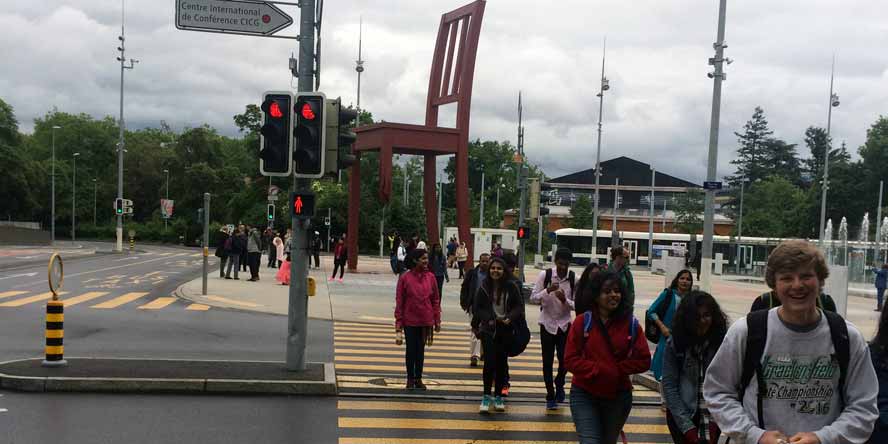
Broken Chair Monument in protest of landmines
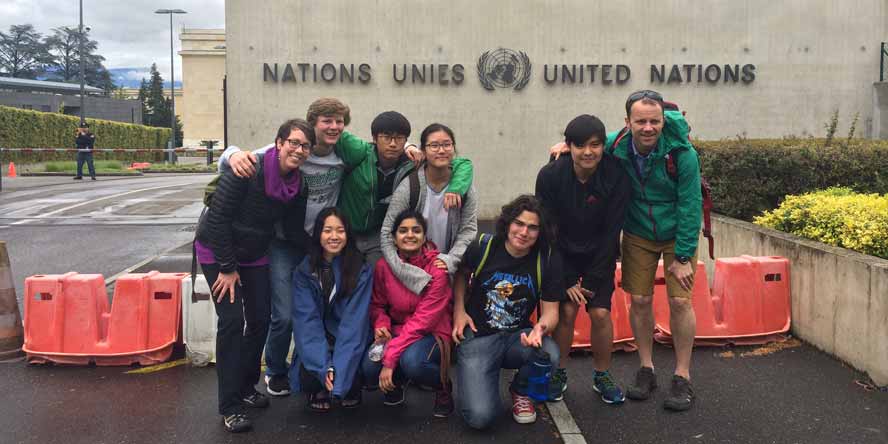
In front of the UN Main Entrance
Grateful for a wonderful opportunity!
Find out more about our approach to education
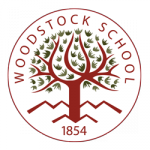





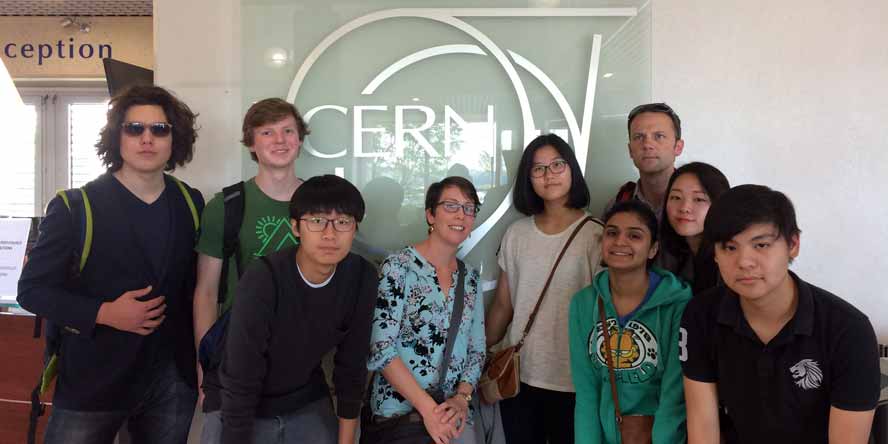
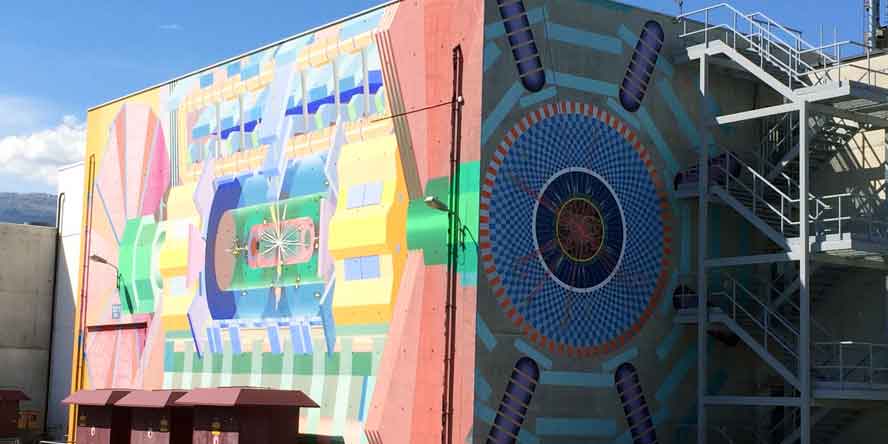
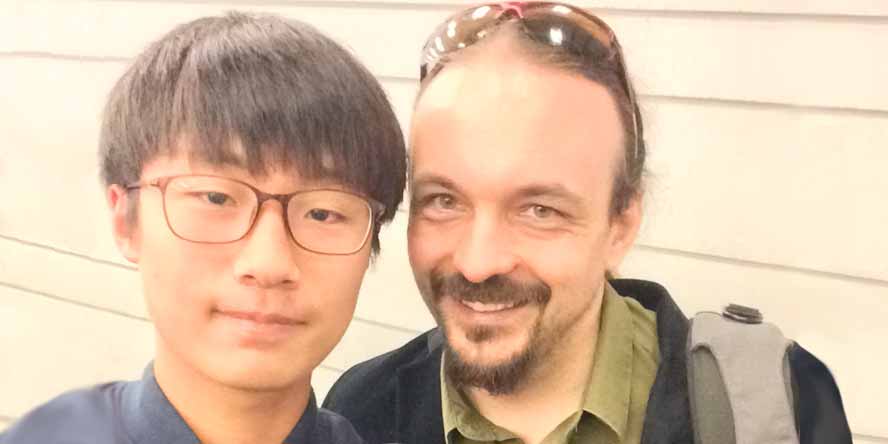
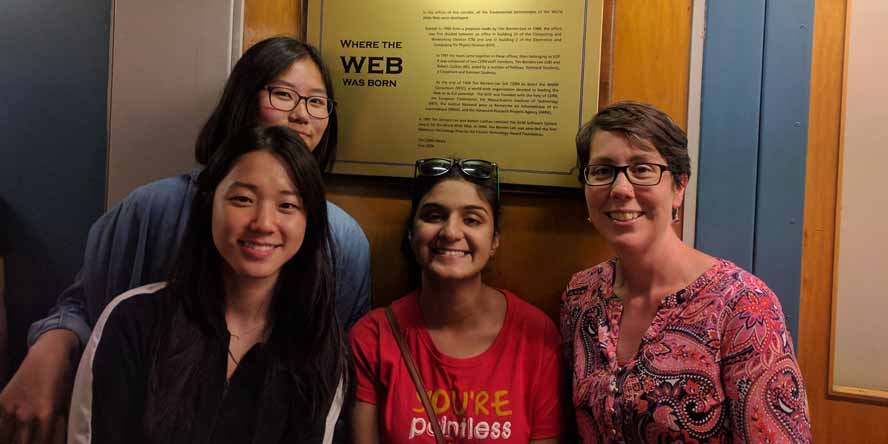
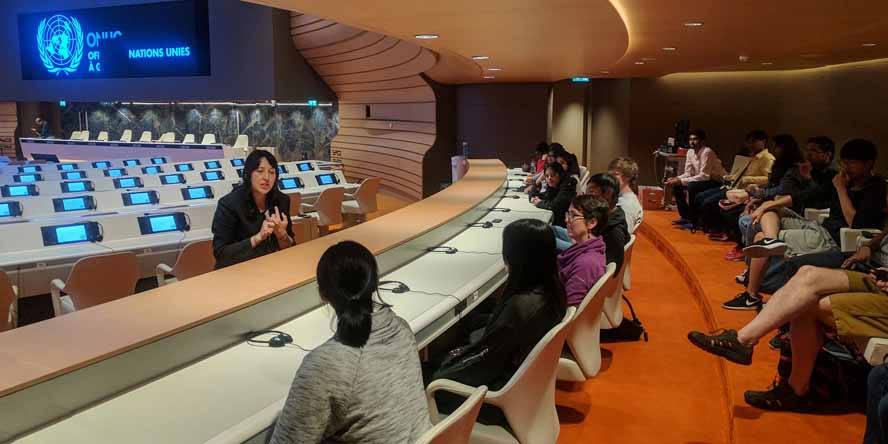
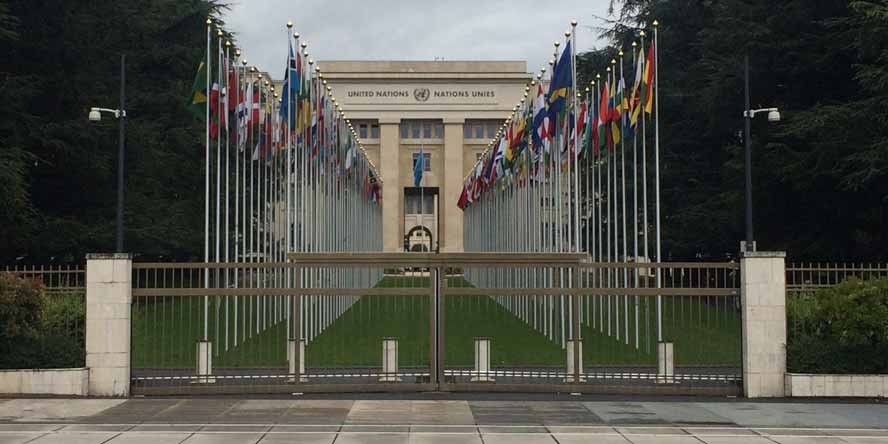
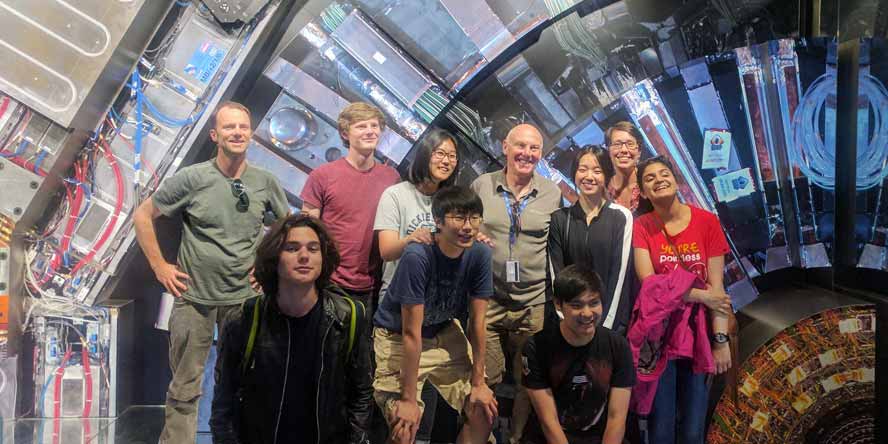
No Comments